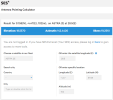Black Hole
May contain traces of nut
I'm still working on how to calculate it.
I'm not sure the formula I've derived is giving sensible results. Update: it is, see post 25.
Last edited:

I'm still working on how to calculate it.
If it gave you that 18.2 then it sounds like it's in the ballpark, which is good.I'm not sure the formula I've derived is giving sensible results.
Ballpark maybe, but it doesn't agree with dishpointer... and more importantly doesn't seem to track in the way I expect when I vary the inputs. I'll hold off publishing the details until I've found the problem (which might turn out to be an error in my expectations, but we'll see).If it gave you that 18.2 then it sounds like it's in the ballpark, which is good.
Beware that whatever skew you decide to set, there might be an existing twist built into the Sky dish LNB support.Thanks for the excellent find of the dishpointer site.

I thought we were served by 2 or 3 satellites, in which case having one with a different skew seems bonkers.there are unsubstantiated reports of Astra 2E being pre-skewed 7.5º

They must all have the same pre-skew, if they are all intended to be received by the same (fixed) dish assembly. Satelliteophiles with motorised steerable dishes also have to have motorised skew.What am I missing here?
So in fact Astra 2E at 28.5 east has no pre-skew of 7.5 degrees, as have 2F and 2G? Have you tested this?Skew 2F,2G is different from skew 2E.....
Not wonderful English, but:I imagine there are technical reasons for this
https://www.satsig.net/maps/geostationary-satellite-polarisation-skew-map.htm said:Some Eutelsat and Astra satellites, may not have their polarisations aligned with the equator. Errors of 3 deg and 7 deg are believed to apply. This minimised the polarisation adjustment required in the central region of the coverage area and reduced cross-polarisation interference during rain, since the bottom of falling rain drops tends to be horizontal.

I now suspect the zero values in that table are only a place-holder, because the polarization is not specified. Perhaps Eutelsat have no responsibility for the Astra transponders, even though they're carried on Eutelsat platforms.I've found a technical document for Eutelsat containing a table of their satellite skews (PDF page indexes 94-95), of which some (including Astra 2E/2F/2G) are given as 0º but mostly 3.535º.
Note that, decoding this, it specifies what the "reference vector" is but not what the "pitch axis" is. OK, so we know what pitch is, its one of the three axes defining orientation in space, but I have not found a figure for it. Could it mean the pitch axis of the receiving antenna? I don't see how. Maybe, therefore, it's the pitch axis of the transmitting antenna, which will depend which way the beam is pointed.The linear polarization planes (defined as X and Y and orthogonal to each other) of most of the Eutelsat S.A. satellites are not parallel/orthogonal to the equatorial plane.
For historical reasons, the polarization planes of the satellites are inclined at an angle with respect to the equatorial plane. This angle is referred to as the polarization offset.
...
The reference X-polarization (horizontal) is defined as that polarization whose plane makes an angle of 93.535° in an anti-clockwise direction, looking towards the earth, about a reference vector with respect to a plane containing this vector and the pitch axis. The reference vector is defined as the vector from the satellite in the direction 0.21° towards West and 6.07° towards north in satellite coordinates. The reference Y-polarization (vertical) is defined as that polarization whose plane is orthogonal to the X polarization plane and the reference vector defined above. In other words the polarization offset angle of the EUTELSAT satellites is +3.535°, clock-wise when looking at the satellite from the earth, from anywhere on the meridian (in the northern hemisphere) corresponding to the orbital location of the satellite. In the southern hemisphere the polarization offset angle of the EUTELSAT satellites is +183.535°, clock-wise, from anywhere on the meridian corresponding to the orbital location of the satellite.
